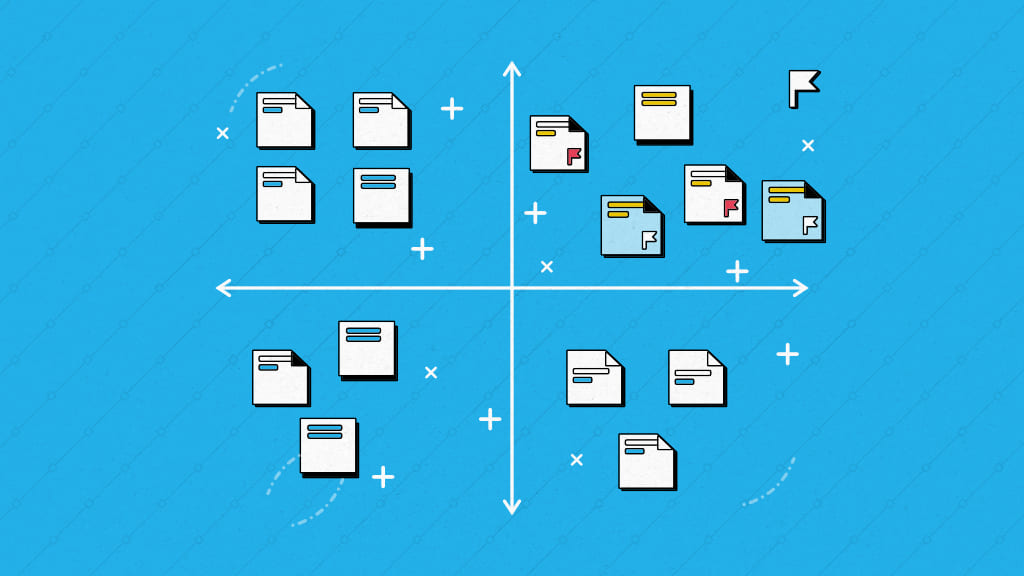Introduction
Are you struggling to prioritize your tasks effectively? Do you find yourself constantly juggling multiple projects and deadlines, feeling overwhelmed and unsure where to start?
It can often feel like there aren’t enough hours in the day to get everything done, leaving you feeling stressed, overwhelmed, and unproductive.
In this article, we’ll share some practical steps and tips for prioritizing tasks and managing your workload effectively.
6 Steps you can take to prioritize tasks
1. Determine the urgency and importance of each task
The first step in prioritizing tasks at work is to determine their urgency and importance.
You can use this to identify which tasks require immediate attention and which ones you can postpone or delegate.
Here are a few methods that can help you prioritize tasks efficiently.
1. Eisenhower Matrix
It is a task prioritization tool that divides tasks into four quadrants according to their urgency and importance. It helps to decide which tasks to focus on first by distinguishing between what is urgent, important, both, or neither. This strategy encourages efficient time management and smart decision-making.
2. ABCDE method
It is a task prioritization technique that ranks tasks based on their urgency and importance. Tasks are labeled from A to E. It allows you to focus on high-priority tasks while managing your workload efficiently within the team.
3. Chunking
Chunking is a task prioritization technique that involves breaking down large tasks into smaller, more manageable chunks. These chunks are then sorted based on their importance and urgency, enabling focus on completing high-priority tasks first. By dividing tasks into manageable chunks, it helps you to improve productivity and efficiency in dealing with complex projects.
4. Eat the frog
It is a task prioritization technique in which you tackle your most challenging or unpleasant task first. This allows you to focus on what’s most important and potentially boost your productivity. The goal is to tackle the most difficult task early in the day, making the rest of your tasks seem easier by comparison. It helps eliminate procrastination and improves time management efficiency.
5. Most Important Task Method
The Most Important Task (MIT) Method is a technique that involves identifying the most important tasks for the day and focusing on completing them first before moving on to less important tasks. By focusing on what matters most, it will help you to enhance your productivity and efficiency in managing the workload.
6. Agile prioritization
Agile prioritization is a method used in project management to decide which tasks you should perform first based on their relevance and urgency. It involves continuous evaluation and adjustment to ensure that the most valuable tasks are completed efficiently. This strategy emphasizes flexibility and responsiveness to changing demands and priorities throughout the project’s lifecycle.
7. MoSCoW prioritization method
This strategy is used to prioritize tasks or requirements in a project based on their importance. It divides tasks into four categories: Must-haves, Should-haves, Could-haves, and Won’t-haves. This method allows you to focus on what needs to be done first, ensuring that resources are allocated effectively.
8. The Ivy Lee method
The Ivy Lee Method is a basic task prioritization technique. It involves jotting down the six most important tasks to complete the next day at the end of each day. The next day, focus on completing these tasks in order of priority without getting distracted. This can help you improve productivity by focusing on important tasks.
9. 1-3-9 prioritization technique
The 1-3-9 prioritization technique helps in task management by focusing on importance and urgency. It involves listing one big goal, breaking it down into three medium tasks, and further dividing each medium task into nine smaller tasks. This method helps you to prioritize tasks based on their significance and ensures a structured approach to finishing them efficiently.
10. Two lists technique
The two lists technique is a simple method for prioritizing tasks. You make two lists: one for urgent tasks and another for important ones. Urgent tasks require immediate attention, whereas important tasks contribute to long-term goals. By separating them, you can focus on what needs immediate attention without ignoring important but less urgent tasks.
11. Pareto principle
The Pareto Principle is also commonly known as the 80/20 rule, suggests that approximately 80% of outcomes come from 20% of causes. It means focusing efforts on the most important tasks that produce the most significant results, rather than dividing attention widely. This can help you increase efficiency by concentrating resources where they can have the most impact.
By identifying the urgency and importance of each task, managers can allocate resources and prioritize work accordingly. This ensures that the most critical tasks are completed first, while less important tasks can be scheduled for later.
2. Set clear goals and objectives
One of the most important steps in the task prioritization process is setting clear goals. It involves identifying the goals, both short and long-term. These goals may be related to projects, your work, your personal life, or any other areas where you have work.
One practical example of setting clear goals and objectives could be to establish a SMART goal (Specific, Measurable, Achievable, Relevant, and Time-bound) for each project or task. This will help you and your team to have a clear understanding of what needs to be accomplished and by when.
For instance, if you’re working on a marketing campaign, you can set a SMART goal of increasing website traffic by 20% in the next three months.
Read more: S.M.A.R.T Goal Setting Practices for Project Managers
3. Communicate priorities with the team
Communicating priorities is an essential step in successfully prioritizing tasks at work. Without clear communication, team members may work on tasks that are less important or not urgent, causing delays in achieving the overall goals. To effectively communicate priorities, here are a few steps.
- Hold a team meeting: Gather your team together and go over the priorities for the day or week. Discuss which tasks are most important and why. This will ensure that everyone is on the same page and knows what to focus on.
- Use a collaboration tool: Utilize collaboration tools to create task lists and assign priorities. It helps to keep everyone informed about what needs to be done, who is responsible for it, and when it needs to be completed.
- Set clear expectations: Make sure everyone understands the urgency of each task and the consequences of delays. Clarify the deadlines and explain the reasons behind the priority level.
- Follow-up: Check in with your team regularly to see how they are progressing and if any adjustments need to be made to the priorities.
- Communicate changes: Priorities can shift quickly in a fast-paced work environment. It’s important to communicate any changes in priorities with your team so they can adjust their work accordingly.
What can you do with ProofHub
With its powerful communication features, including chat, you can easily share updates and changes to the team’s priorities in real-time.
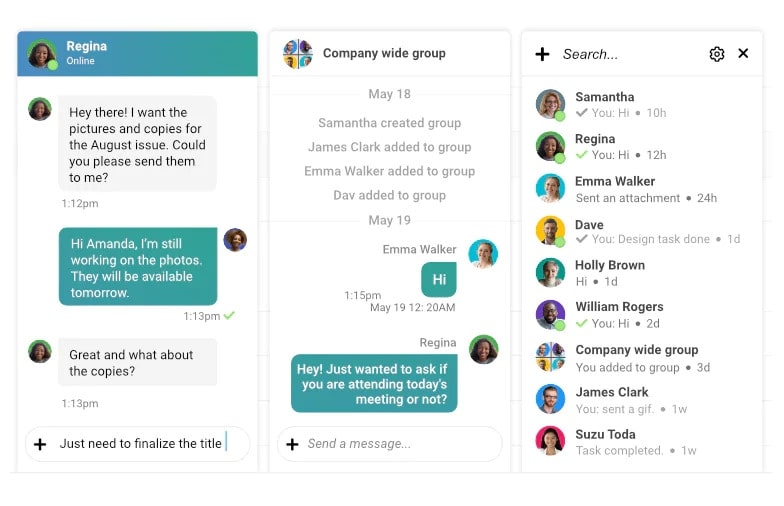
Additionally, ProofHub allows you to assign tasks to team members, set deadlines, and track progress, ensuring that priorities are being met efficiently. For instance, you assign priorities to each task and set deadlines, and it automatically sends reminders to the team members. This helps everyone to stay on track and ensures that tasks are completed on time.
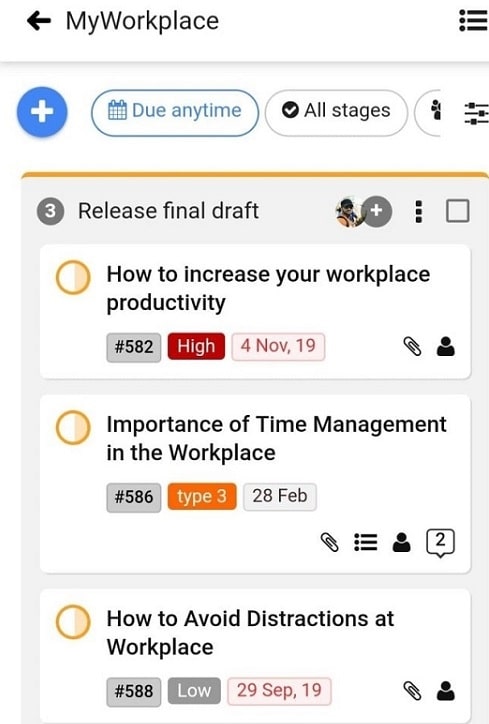
4. Schedule tasks
Scheduling tasks may seem like a straightforward process, but it involves much more than just adding items to your calendar. It requires you to take a step back, evaluate your workload, and determine the most efficient way to allocate your time.
- The first step in scheduling tasks is to determine which tasks require immediate attention and which ones can wait. This way, you can focus on what matters most and ensure you are making progress toward achieving your goals.
- Once you have identified your priority tasks, the next step is to assign them specific time slots in your calendar. This will help you visualize your day, ensure you have allocated enough time for each task, and avoid overcommitting yourself.
- Another important aspect of scheduling tasks is to stay flexible. Be prepared to adjust your schedule when unexpected tasks or issues arise. This is where a prioritization system comes in handy.
By having a clear understanding of which tasks are most critical, you can quickly adjust your schedule to accommodate unexpected challenges while still making progress toward your goals.
What you can do with ProofHub
ProofHub’s Scheduling Calendar helps you organize and visualize all your scattered events, tasks, and milestones in one place. You get the option for adding “automatic reminders” for your events and milestones, recurring events, and tasks without having to create them again.
You can can also merge your ProofHub calendar with the ones you generally use and avoid referring to multiple calendars.
ProofHub’s Scheduling Calendar organizes all your tasks, events, and milestones in one place. Stay on top of your deadlines and never miss anything important.
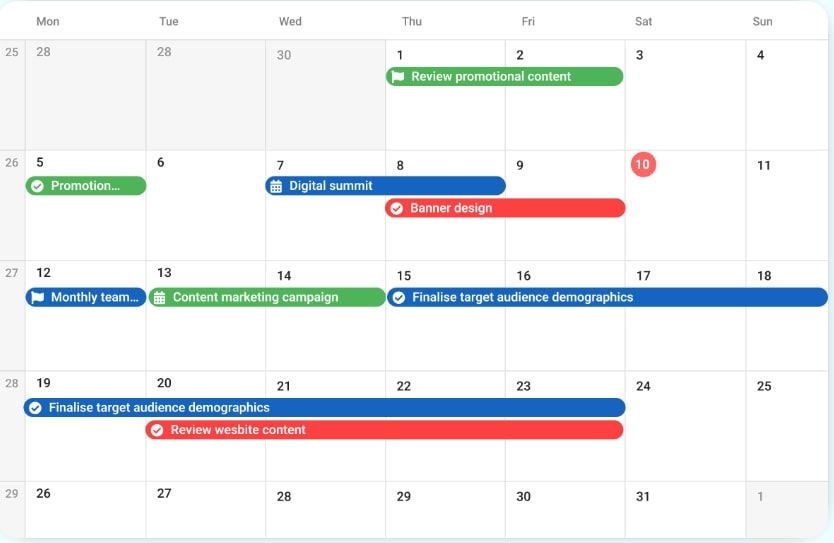
Read more:What is a Milestone in Project Management
5. Assign responsibilities based on strengths and skills
Moreover, one important step to prioritize tasks at work is to assign responsibilities based on the strengths and skills of team members. This strategy ensures that each team member is working on tasks that they are best suited for, thereby increasing efficiency and productivity. Additionally, it is crucial to communicate these priorities clearly with the team, ensuring that each member understands their role and the expectations for their work.
Here are some tips for communicating priorities:
- Identify team member strengths and skills: Before assigning tasks, identify the strengths and skills of each team member. This will help you assign tasks that are best suited for each individual and ensure that they are able to complete them efficiently.
Example: If you have a team member who is particularly skilled in graphic design, assign them tasks that involve creating visual content. - Clearly communicate priorities: It’s important to clearly communicate priorities to your team. Make sure they understand what needs to be done first, what can wait, and what tasks are most critical to the project’s success.
Example: If you’re working on a project with a tight deadline, make sure your team understands the urgency and prioritizes tasks accordingly. - Provide regular updates: As priorities change, provide regular updates to your team. This will ensure that everyone is on the same page and that tasks are being completed in the correct order.
Example: If a new task has been added to the project, make sure to notify your team and explain how it fits into the overall priorities. - Encourage collaboration: Encourage collaboration among team members to ensure that tasks are being completed efficiently and that everyone is working towards the same goal.
Example: Encourage team members to work together on tasks that require multiple skill sets to complete, such as creating a presentation or writing a report.
By following these steps, you can assign responsibilities based on strengths and skills, communicate priorities effectively, and ensure that tasks are completed efficiently.
What can you do with ProofHub
With ProofHub, you can easily identify each team member’s strengths and skills through their profiles and previous project performances. This allows you to delegate tasks to the person best suited for the job. By utilizing ProofHub’s feature to assign tasks based on skill set, you can ensure that everyone is working on tasks they are comfortable with, which not only results in better quality work but also boosts team morale.
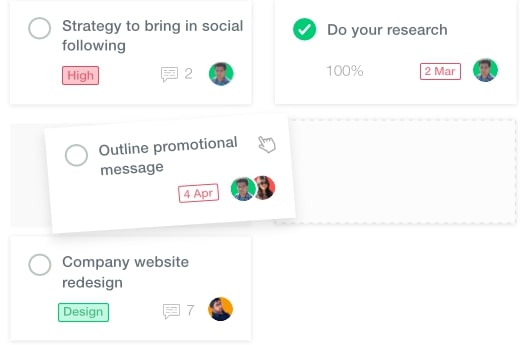
6. Regularly review and adjust priorities
Regularly reviewing and adjusting priorities is a crucial step in effectively managing tasks at work. Therefore, you can stay on top of your workload and ensure that you are making progress toward your goals. Additionally, check on the progress of tasks and see if any modifications are required. Don’t be afraid to make changes and stay flexible as you navigate your daily tasks.
Here are some helpful points to keep in mind:
- Set aside time for regular reviews: Schedule regular intervals, such as once a week or every few days, to review your tasks and priorities.
- Evaluate your progress: Take a look at how you’re progressing on your tasks, and decide if you need to adjust your priorities to stay on track.
- Be flexible: Priorities can change quickly, so it’s important to be open to adjusting them as needed.
- Consider urgent versus important tasks: Make sure you’re prioritizing the tasks that are both urgent and important, not just one or the other.
- Eliminate or delegate lower-priority tasks: If you find that certain tasks are no longer a priority, consider delegating them to someone else or eliminating them altogether.
Here are some examples to regularly review and adjust your priorities:
- If you’re working on a project with multiple team members, schedule a weekly check-in to evaluate progress and adjust priorities as needed.
- Use a task management tool to keep track of your tasks and prioritize them based on urgency and importance.
- If you’re struggling to keep up with your workload, take a step back and evaluate which tasks are most critical to your success, and delegate or eliminate lower-priority tasks.
Reviewing and adjusting your priorities regularly enables you to stay focused on the most important tasks and prevents less important ones from bogging you down.
What can you do with ProofHub
As you work through your tasks, you can use ProofHub to regularly review your priorities and adjust them as needed. With features like task lists, Gantt charts, and Kanban boards, you can easily organize your to-do list and visualize your progress. For example, if you realize that one task is taking longer than anticipated, you can re-prioritize your other tasks accordingly. This way you can stay on top of your tasks and ensure that you’re always focusing on what’s most important.
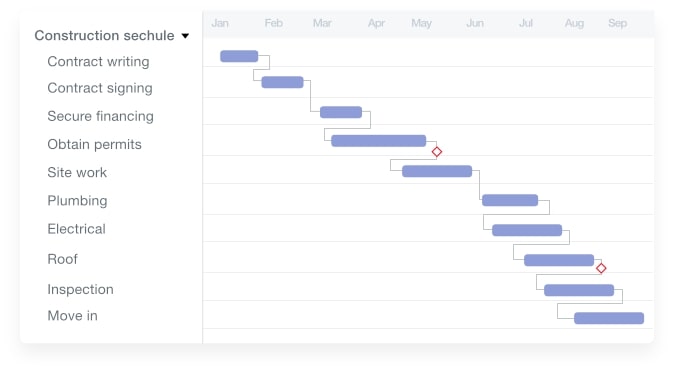
Useful tips for prioritizing tasks at work
While using a powerful project management and team collaboration tool like ProofHub will help you sort out your task management issues, there are other tips too that are as important.
We have listed some useful tips that will help you prioritize your work in the workplace and deliver high-value work consistently.
1. Focus on one task at a time
Try to avoid multitasking and focus on one task at a time. This will help you maintain your focus and productivity and ensure that you complete each task efficiently.
2. Determine the impact of each task
We have mentioned earlier that not all tasks are the same in terms of their impact on the project. When you create your task list, I recommend you should assess the impact each task will have on the business or project. High-impact tasks are generally the ones that deliver the greatest value to the organization’s objectives.
3. Consider the deadline
We believe that many people miss deadlines because they don’t schedule their tasks accordingly. Say if you have five tasks lined up, consider the deadline for each task.
Don’t look at how complex or simple the task is, but focus on tasks that have the nearest deadline or are the most time-sensitive. Generally, you should start immediately on the task with the nearest deadline and arrange other tasks sequentially.
4. Evaluate the level of effort
This step requires you to consider how much time and resources each task will require. You might need to assign multiple assignees to a single task if they are difficult or time-consuming. On the other hand, you can assign a single assignee to a task if it’s relatively straightforward.
5. Review resources
Whether you are managing single or multiple projects, you would need to identify available resources and allocate tasks accordingly. Only prioritize tasks that can be completed with the available resources.
6. Consult with your team
When figuring out how to prioritize tasks at work, don’t forget to loop in team members who can offer valuable inputs to help you determine what tasks are most important to them and how they can best support the completion of these tasks.
Also, consider the efficiency of your team members in different tasks.
7. Don’t forget to take breaks
Finally, don’t forget to take breaks throughout the day. Taking breaks can help you recharge and increase your productivity, allowing you to complete your tasks more efficiently.
Adjust schedules as work changes and deadlines shift with ProofHub.
Conclusion
If you are struggling with prioritization of tasks then look no further than the steps listed in this article. To make sure your team invests valuable time in the right things, you should use powerful project management software like ProofHub to have greater control over teams and projects.
Sign up for ProofHub now and you’ll notice a boost in team productivity as your team members are able to work on tasks that deliver high value to the project as well as the organization while saving themselves from unwanted stress, frustration, and excessive workload.
So, make the smart decision now and utilize your resources in the most efficient way.
